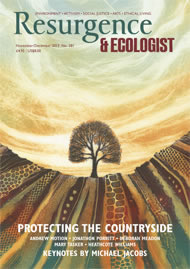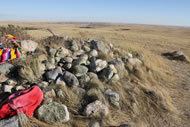“The pond” is how Ryan and his wife Adrienne referred to the Helen Schuler Nature Reserve sitting between Lethbridge and the edge of the Blood Reserve, a band of land that is part of the Blackfoot Confederacy in southern Alberta. The area is home to a variety of birds and other animals including turtles, rabbits, bats and beavers, whose large family lodges have a central location in the pond amongst the nesting birds as if they were the guardians of the valley.
Ryan and Adrienne have been coming to this place for many years, coming to know its many plants and animals intimately, even as individuals. Their immersion in this place is of such quality that the place and its animals have also come to know them, at moments showing them where to collect foods and medicines. Ryan and Adrienne showed me around this place during a recent stay in Canada and explained how they came to learn from it and how this relates to Blackfoot ways of learning and to the stories concerning the relationships of humans to place and other beings. They also told me how this learning has become translated into a one-year course at Red Crow Community College, the first Tribal (First Nations) college in the country, which is teaching Blackfoot ways of knowing in a higher education institution.
How did we end up spending time with Red Crow Community College?
We have been learning and working within an academic context for the past 20 years as students, researchers and teachers. Yet over the last 10 years or so we, and many of our colleagues, have experienced a learning environment increasingly stifled by bureaucracy, management and the growing influence of the profit-motive. We have also grown increasingly suspicious that within these institutions, as elsewhere, there are deeply ingrained ways of knowing, identifying, relating and valuing that is the very engine of contemporary crises.
Our decision to leave our academic jobs and visit a number of higher education initiatives internationally that have emerged through indigenous communities and social movements has been not only to deepen our own understanding of each initiative we are visiting, but also to learn other ways of being, knowing and learning and share these with others.
Red Crow Community College (the first initiative we visited on our journey) is located near a small town called Standoff, in southern Alberta, Canada. This is a post-secondary college spread over two campuses with around 270 students and 40 staff that teach a range of courses. What made the college distinct from other colleges we know is the two-year Kainai (Blood tribe) Studies course they have offered since 2005. On this course, students learn the Blackfoot language, Blackfoot history, geography and religion and from Ryan, (a Blackfoot teacher at Red Crow) they learn from the land and animals of this region.
Central to our encounters and conversations with the people associated with Red Crow College, and the other initiatives we have visited, have been questions related to epistemology. That is the philosophical enquiry into the nature of knowledge and knowing, of what is considered ‘knowledge’, how we acquire it and in cases of different traditions of enquiry, such as that between the Blackfoot and ‘global’ science, how and why does one prevail over the other.
At the heart of Blackfoot 'ecological-spiritual' knowledge and practice are the various medicine bundles; these are the material objects that embody this set of knowledge and serve as focal points in the ceremonies and exchanges related to each bundle. In Blackfoot, the term used is amopístaani, which translates as 'bound-together-by-wrapping-around'. The significance of this binding together describes not only the physical bundling of various material components but also the binding of beings through contractual relationships. One of the most important bundles for the Blackfoot is the Beaver Bundle.
In conversations with Ryan and Adrienne, as well as with Narcisse, the cultural translation of the Beaver Bundle would amount to something like the material and ceremonial embodiment of the relationships that humans have with other plants, animals and beings. These relationships, which relate back to the stories of how humans first received the Bundle from the Beaver people, involve both a knowledge of the behaviour and environment of a variety of beings and the reciprocal conduct humans ought to have with these, so as to ensure a balanced co-habiting in this place.
For me, the inspiring learning from this practice of the Beaver Bundle has been how 'knowing’ is intrinsically bound to entering into relationships with; place, people and non-human beings. Also, the authoritative sources of learning are much broader than in traditional academic epistemology to include dreams, landscape, plants, animals and other beings. This epistemological expansion shifts the human intellect from the centre of the universe placing it instead as one amongst many other intelligences from whom we can learn. Ethically, this means that the world is not only there to gratify human needs and desires but rather it is a network or bundle of relationships we learn to enter into.
This is clearly evident in Ryan Heavy Head’s class on Blackfoot ecological knowledge and traditional foods at the college. Here, in the first year, he asks his students to find a place they will visit and stay put for two to three hours, at least three times per week, every week, over the course of one year. During these hours, they are asked to sit – observe, listen and touch. They are tasked with learning the literacy of the land. Written forms of literacy in this learning context are narrowed to books that help to identify each species of birds, animals, plants and insects (in both Blackfoot and English languages) that live and visit the place and written reflections about their experiences of learning. Gradually the students also come to know the habits of individual beings and their responses to the changing seasons. As part of this process of learning, students develop deep relationships to the place.
As well as getting to know the land and its beings the Kainai Studies course also involves visiting historical and sacred sites for the Blackfoot found in their traditional territory. These sacred sites lie outside their reserve which they did not have access to for nearly 100 years, until the middle of the 1960s. The process of deeply and intimately getting to know place provides a different approach to what might occur in disciplines of geography, archaeology, ecology, botany or zoology. As the course outline puts it:
“In all of these activities, participants reflect upon a core question: Where is here? What do various responses to this question suggest about relationships between knowledge, identity, and place? How do shifts in one’s sense of emplacement – as through the introduction of niitsitapi [Blackfoot] stories, concepts, and approaches, for instance – affect one’s responses to the core question over time? What might these transformations mean? And how might engagements with and senses of place shape one’s life-long learning experiences?”
The inspiring effects of the course on a number of students from the college we talked to were clear to see. Many spoke of rediscovering their history, their identity, of reconnecting with their ancestors, with grandparents, their land, and most importantly with a sense of pride and value of a way of life that had been oppressed for many decades. But the course has also been taken by non-Blackfoot, people who came to find a renewed connection and responsibility to the place they live in.
The Blackfoot have been around for thousands of years and have learnt how to live in this place in balance with its beings, developing a way of knowing-being-doing that is connected to the land, its residents and natural cycles. The most important and revered embodiment of this approach to living in this place is found in Beaver Bundle.
What courses such as Kainai Studies teach is how to restart this process of learning from and living in place, developing a new sensibility, identification with and literacy of the land and its beings but this time through a higher education institution. Red Crow Community College poses many challenges, offering different possibilities of learning to traditional academic institutions. They offer their own answers to the question of what a university is for, what is knowledge and learning and how are these linked to our ways of living and relating in place and to each other.








